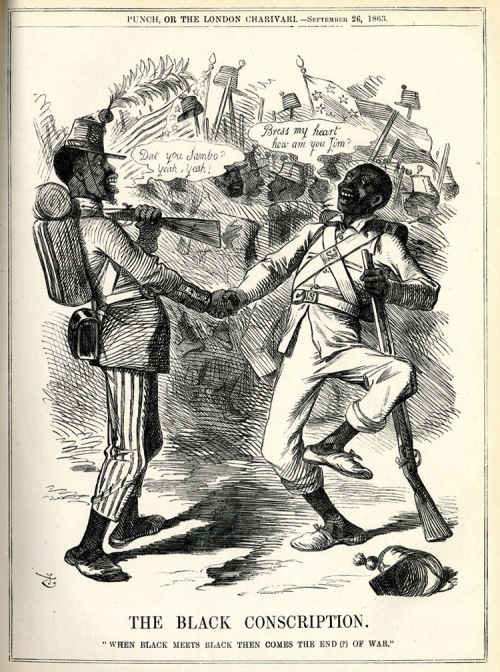Fear of a Black planet? The hypocritical emancipatory liberalism of John Stuart Mill that seems to reinforce patriarchy, racism in the most delectable sugar coating that today’s pop culture can occultishly conjure up. O Brave New World of Shakespeare’s The Tempest; the land of the free where birthright was no obstacle to all enjoying the abundant manna. As Shakespeare foresaw based on the initial Jamestown settlement, the locals would be colonized and subjugated and the utopian hope of America would be killed of and reborn continuously under different guises. Is Romney Prospero? Is Obama really Caliban? The rugged individualist and the dynastic families of Bush, Kennedy et al….
The Black Conscription.
When Black Meets Black Then Comes the End(?) of War.
Punch, Volume 45, September 26, 1863, p. 129
To modern sensibilities, this is one of the most offensive of Tenniel’s cartoons, as its theme is the notion that black men are incapable of becoming good soldiers. In a (wholly hypothetical) meeting of Union and Confederate black troops on the battlefield, martial ardor dissolves into comic stereotype. The Northern conscript is identifiable by his striped trousers. His Southern counterpart, dressed in a white cotton uniform distinguished only by a capital letter “S” on his belt and bandolier, breaks into an open-mouthed grin and begins to caper as the two clasp hands. Behind them, surrounding their respective flags, representatives of the two black conscript armies socialize with obvious amiability, forgetting all pretense of military discipline. In word balloons, the Northern soldier asks “Dat you Sambo? Yeah, yeah!” while his Southern counterpart responds “Bless my heart, how am you, Jim?” Read More:http://mulattodiaries.wordpress.com/2011/04/14/sambo-meets-jim-crow/ …
While the ranks of Northern black regiments ultimately included many “contraband” fugitives from slave states, the earliest black troops (such as the famed 54th Massachusetts) were recruited exclusively from the free black populations of Northern states. Many of these units acquitted themselves bravely on the field of battle. Officially, there was no conscription of blacks as combat soldiers by either side: all were volunteers. While blacks were used by the Southern forces throughout the war in non-combat roles (especially as laborers for tasks such as the construction of fortifications), the raising of black troops to fight for the Confederacy, though proposed cautiously by a few within the military, was vehemently resisted by most Southerners as deleterious to the slave system until the war was almost over. There is no record that the few units of black Confederate soldiers, organized during the final weeks before the fall of Richmond (nearly eighteen months after the publication of this cartoon), ever met black Union troops in combat. The name Sambo, the “characteristic” dialogue of the two principal figures, and the capering dance of the Southern black soldier all are based on the stage caricatures of blacks presented by (mostly white) actors wearing burnt-cork makeup in the minstrel shows popular during the mid-nineteenth century, some of which had toured to London.
The cartoon’s subcaption is a play on the old English proverb “When Greek meets Greek, then comes the tug of war,” a way of describing a situation in which two sides are so equally matched that neither is likely to prevail. Its use is documented as far back as the seventeenth century, and it had been quoted by the popular novelist Anthony Trollope as a chapter title in Doctor Thorne, published a few years prior to the Civil War in 1858. Read More:http://mulattodiaries.wordpress.com/2011/04/14/sambo-meets-jim-crow/








 COMMENTS
COMMENTS



